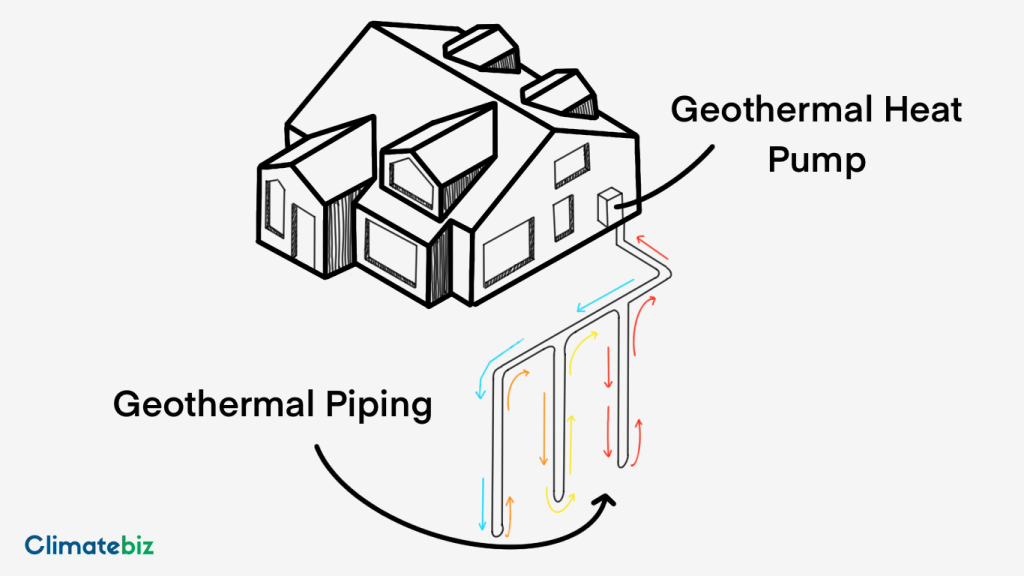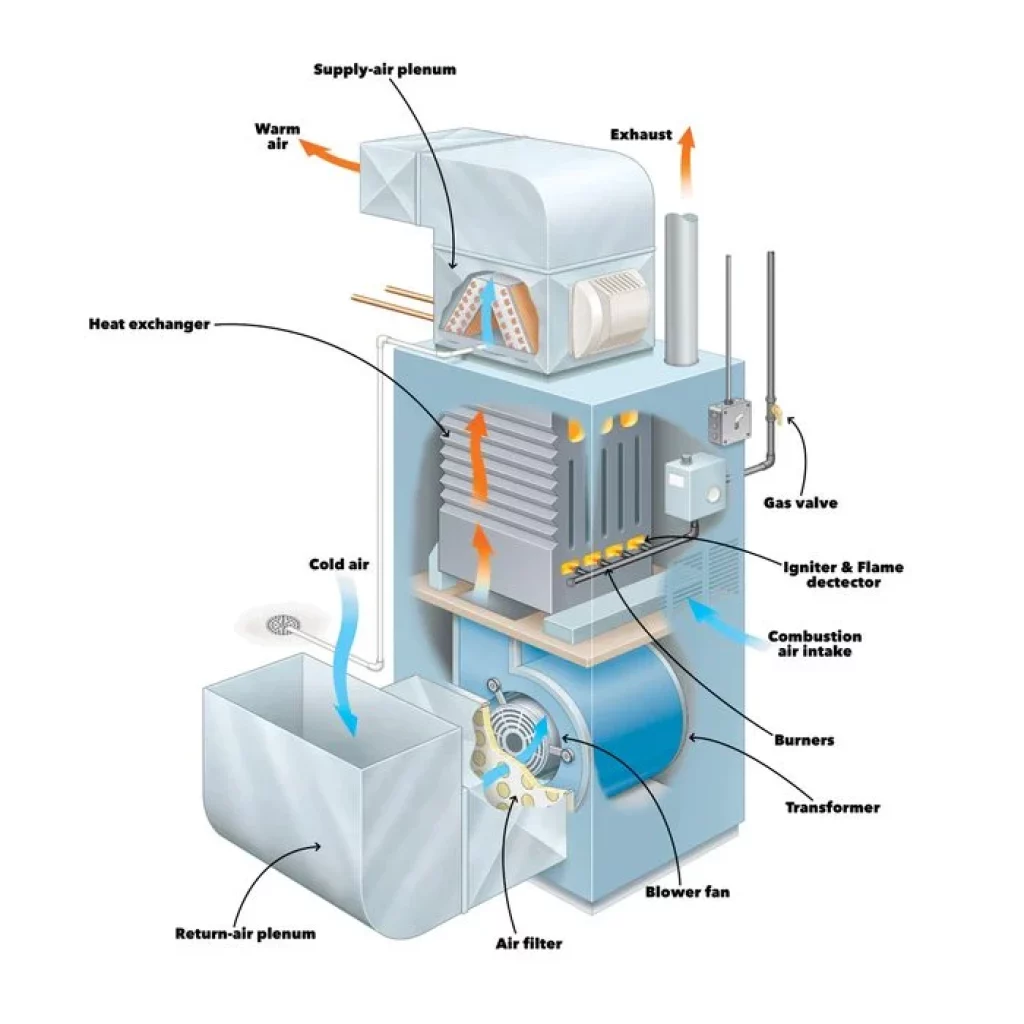Geothermal heat pumps vs. gas furnaces — both are effective methods for household heating, cost-wise and heat-wise. However, only one can be crowned the most efficient.
Our article explores the two heating methods, uncovering their environmental impact, costs involved, and tax credits offered.
While this article targets people residing in the U.S., you can always contact your local municipalities to learn more about both units in your area.
Table of Contents
Geothermal Heat Pumps Vs. Gas Furnaces
| Geothermal Heat Pump | Natural Gas Furnace |
|---|---|
| Geothermal heat pumps are efficient and versatile. Without adaptations, they provide sustainable heating and cooling for your home year-round. | Natural gas furnaces are used primarily for heating, but installing a different system for cooling is possible. |
| A GHP transfers natural heat from below the Earth’s surface to cool or heat your home and has no fuel source. | Gas furnaces use natural gas, which consists of methane and other carbon gases, as a fuel source. |
| A GHP uses a loop system that harnesses the underground temperatures to cool and heat your home or commercial building. | Natural gas furnaces work with combustion to produce heat which thus warms your home. |
| Since a GHP needs electricity to work, it indirectly gives off carbon emissions. However, this can be curbed by using alternative energies to power your GHP, like solar or wind power. | Natural gas furnaces don’t have an intensive impact on the environment due to their low immersion rate. Gas furnaces emit Carbon Monoxide that can be deadly to humans if furnace vents are broken or faulty. Additionally, high amounts of Carbon Monoxide can harm the environment around you. |
Is Geothermal Heating More Efficient Than Gas?
While both systems use energy to generate heat, geothermal heating is more efficient than natural gas furnaces.
Because geothermal systems only use one unit of electricity to generate 4 units of heat, their efficiency towers above gas furnaces.
With furnaces, only 80% of the fuel burnt goes towards heating while the other 20% is disposed of as exhaust.
Why Is Geothermal Heating So Efficient?
Geothermal heating is efficient due to the small amount of electricity needed to produce five times the heat. This is because geothermal heat pumps work based on transferring heat instead of creating heat.
About five feet below the Earth’s surface, the temperature remains constant because the soil’s thermal mass absorbs the sun’s heat, keeping the deeper parts of the soil cool. In winter, the opposite occurs, where the thermal mass prevents heat from leaving.
Geothermal heat pumps take advantage of heat retention. A system of pipes loops five feet below the surface using conduction. Heat transfers from the ground into the liquid inside the pumps.
The liquid then passes through the heat pump, turning it into a gas. Next, the gas is passed through a pressure valve, increasing the temperature as the gas compresses. Finally, the gas condenses into a liquid and travels through the heat distribution system.

Source: ResearchGate
To summarise, geothermal heating is efficient for the following reasons:
- It uses existing heat
- It uses a great heat conductor
- It has multiple uses (they heat and cool your home)
Please note: you can follow our guide to calculate how much electricity geothermal heat pumps use.
What’s the Main Difference Between Geothermal Heat Pumps Vs. Gas Furnaces?
To reiterate, geothermal heat pumps use existing heat, while natural gas furnaces need to generate heat through combustion.
Comparison
Now, let’s compare the requirements to heat an average 2,500-square-foot home.
Two thousand five hundred square feet requires 75,000 BTU to maintain a comfortable temperature. The average geothermal heat pump requires 5.49 kWh to generate 75,000 BTU.
Additionally, you’d need 72 cubic feet of natural gas to generate 75,000 BTU. That converts to roughly 21.19 kWh.
Therefore, this example shows that geothermal heat pumps are 74% more efficient than natural gas furnaces. This is supported by the EPA’s research which states that geothermal heat pumps are 72% more efficient than natural gas furnaces.
Is Geothermal Or Gas Heating Better For The Environment?
Natural gas heating has a more significant negative impact on the environment due to its emissions. In contrast, geothermal heat pumps have a low environmental impact – producing no direct emissions.

Environment
Geothermal heat pumps produce 75% less carbon dioxide emissions than standard heating/cooling systems. That said, Geothermal heating isn’t 100% clean either. While your heat pump won’t give off emissions, the electricity used must be considered.
For example, coal power plants produce 767 million metric tons of carbon dioxide to generate 757,763 million kWh. While only a fraction of this is used for geothermal heat pumps, it still contributes to the bigger picture.
Conversely, natural gas furnaces directly release carbon monoxide into the atmosphere through combustion. According to the Centers for Disease Control and Prevention (CDC), 50,000 people are rushed to the emergency room yearly due to carbon monoxide poisoning. Even worse, at least 430 people die due to this poisoning.
Lastly, natural gas furnaces contribute to acid rain.
Materials
Geothermal piping systems are made from high-density polyethylene and have a lifespan of about 50 years. In addition, when they reach the end of their lifespan, they don’t pose any environmental risks.
In contrast, modern furnaces use stainless steel, aluminum, brass, copper, and fiberglass. They typically have 15 years, after which they need repairing or can be used as recycled scrap metal.
Which Is Cheaper, Geothermal Or Gas Heating?
Natural gas heating is cheaper than geothermal heating. However, geothermal heat pumps last longer and have an ROI period of 4 to 15 years. Since geothermal heat pumps last up to 50 years, it’s worth the price. Other factors to consider are the operation and installation costs.
Cost Of Operation: Geothermal Heat Pumps Vs. Gas Furnaces
The cost of operation varies depending on your electricity bill, natural gas consumption, and state.
In 2021, the average cost of electricity in the United States was 13.72 cents per kilowatt hour (kWh). This means that a geothermal heat pump costs around 0.75 cents per hour.
A natural gas furnace of the same capacity would cost $0.69 per hour. However, remember that 20% of that gas won’t generate heat and will be used up during combustion.

Source: familyhandyman
Related Reading: How Much Electricity Do Geothermal Heat Pumps Use?
Installation Costs
The final cost to consider is the cost of installation.
Natural gas furnaces are cheaper to install but have a shorter lifespan. But let’s make this comparison fair by dividing the installation cost by the unit’s lifespan.
Geothermal heat pumps cost around $10,000 to $30,000. That’s an average installation cost of $20,000. Now, if we divide that by the heat pump lifespan of 50 years, we get $400.
Conversely, gas furnaces cost between $3,800 and $10,000 to install; this averages out to $6,900. When you divide the cost by the lifespan, the installation would cost $460.
Therefore, while a natural gas furnace has a low start-up cost, geothermal heat pumps are cheaper in the long run.
Geothermal Heat Pumps Vs. Gas Furnaces: Do Both Have Tax Credits?
Both geothermal heat pumps and gas furnaces have tax credits and incentives in the United States. Geothermal heat pumps offer a 26% tax credit until 2025, which will decrease to 22% and entirely fall away in January 2025.
Gas furnaces have a maximum tax credit of $200. This credit applies to the unit’s circulation fan ($50) and boiler ($150).
If you buy a geothermal heat pump today, you can get up to $5,200 in tax credit. However, if you’re considering this heating option, we highly recommend you buy your unit before the end of 2025 to receive any form of a tax credit.
Related Reading: What Is The Cost Of A Ground Source Heat Pump?
Final Thoughts
It’s a close call when comparing these two heating units.
Natural gas furnaces have a lower installation cost and an arguable cheaper operational cost. However, their efficiency is lower than geothermal heat pumps and has a more significant environmental impact.
Conversely, a geothermal heat pump uses 1 unit of electricity to generate 4 units of heat. This ratio makes geothermal heating one of the most efficient home heating methods. In addition, you can use them year-round, regulating the temperature of your house with heating and cooling options.
If you’re looking to turn your abode into an eco-home, you can consider installing solar panels to subsidize the electrical usage of the geothermal heat pump.
We hope this article has cleared things up. To continue the conversation and stay up to date with the latest green tech news, follow us on Twitter.

